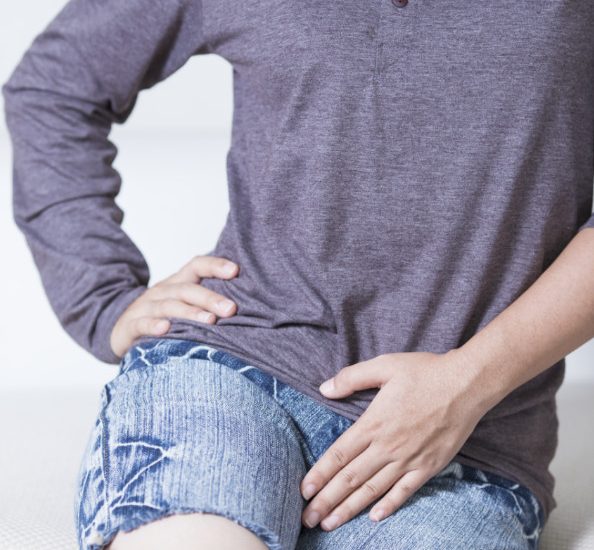Hemorrhoids are a common problem of the anus and rectum. They occur when the veins around the anus or lower rectum become swollen and inflamed, often as a result of straining during a bowel movement, sitting for long periods of time, or long-term constipation.
Symptoms include bright-red blood on the toilet paper, anal discomfort, and itching. Fortunately, the problem can be treated with dietary changes and healthy bowel habits. In more severe cases, a procedure or surgery may be required.
WHAT ARE HEMORRHOIDS
The term hemorrhoid refers to a condition in which the veins around the anus or lower rectum are swollen and inflamed.
Hemorrhoids are common in both men and women. About half of the population has hemorrhoids by age 50.
TYPES OF HEMORRHOIDS
Internal Hemorrhoids – these usually remain along the anal wall. You probably won’t see or feel them, unless they break through the anus. This is known as a protruded or prolapsed hemorrhoid. Symptoms may include pain, bleeding, itching and a feeling of fullness after a bowel movement.
Internal hemorrhoids are classified according to a system of grades.
Grade One internal hemorrhoids do not protrude from the anal canal, though they may cause other symptoms such as bleeding or itching.
Grade Two hemorrhoids are at the first stage of hemorrhoidal prolapse, which is to say that they protrude from the anal canal during a bowel movement but retract back into the body upon completion of said bowel movement.
Grade Three hemorrhoids protrude from the anal sphincter during a bowel movement and do not retract upon completion, but will stay inside if pushed back in manually. Grade Three hemorrhoids have a tendency to bleed more often and are generally easier to inflame.
Grade Four hemorrhoids protrude from the body all the time. If pushed back in, they will slip out on their own shortly with no effort required. Hemorrhoids this severe need to be seen by a doctor, as they bleed much more easily, are prime targets for infection, and may develop an internal blood clot, also known as thrombosis.
External hemorrhoids – these are small soft pads around the anal opening, the same color as your skin. When an external hemorrhoid forms a blood clot (thrombosis), it can appear blue in color and cause severe pain, itching and inflammation.
CAUSES, TREATMENT AND PREVENTION
One of the most common causes of hemorrhoids is straining to pass hard, dry stools during bouts of constipation. Other factors that can lead to hemorrhoids include:
Straining to lift heavy objects
Pregnancy
Obesity
Sitting for long periods
Diarrhea
Pregnancy
WHEN TO SEEK CARE
Generally, hemorrhoids are not serious and symptoms go away in a few days. However, sometimes hemorrhoids may signal a more serious problem. See your health care provider if any of the following occurs:
Rectal bleeding. Although this is a common symptom of hemorrhoids, rectal bleeding could be a symptom of a more serious disease.
Persistent pain. In some cases, hemorrhoids must be removed surgically. Your doctor will perform an exam and decide on the best course of treatment.

PREVENTION
Take the following steps to reduce your risk of hemorrhoids:
Eat more fiber and drink plenty of fluids. This will help soften stools and promote regular elimination, which reduces straining.
Go when you feel the urge to have a bowel movement. Delaying now can mean straining later.
Don’t read on the toilet. Sitting and straining too long encourages swelling.
Wipe gently with soft, white, unperfumed tissue. This helps keep the area clean to avoid irritation.
Exercise regularly, which aids digestion and improves circulation.
TREATMENT
Treating hemorrhoids may require nothing more than home treatment and lifestyle changes. For instant relief of pain, itching and swelling, try the following:
Apply a hemorrhoidal cream or suppository to the affected area as directed.
Use ice packs, which can reduce swelling.
Soak in a warm bath or “sitz” bath (sitting in three inches of water) for 10 minutes a few times a day.
Talk with your health care provider during your next visit. To encourage better bowel movements, your health care provider may suggest some lifestyle changes, such as increasing your fiber and fluid intake and exercise.
If these changes do not help, your health care provider may suggest a fiber supplement or a stool softener
In some cases, treatment may require a surgery or procedure. Some situations where hemorrhoid surgery may be recommended include: Hemorrhoids that bleed repeatedly, Prolapsed hemorrhoids, Thrombosed hemorrhoids, Extremely painful hemorrhoids.
Four types of surgery are generally recommended to treat hemorrhoids. These options include:
- Rubber band ligation
- Sclerotherapy
- Infrared coagulation
The following is a quick summary of treatment for internal hemorrhoids by grade:
- Grade I hemorrhoids are treated with conservative medical therapy and avoidance of nonsteroidal anti-inflammatory drugs (NSAIDs) and spicy or fatty foods
- Grade II or III hemorrhoids are initially treated with nonsurgical procedures
- Very symptomatic grade III and grade IV hemorrhoids are best treated with surgical hemorrhoidectomy
Treatment of grade IV internal hemorrhoids or any incarcerated or gangrenous tissue requires prompt surgical consultation


